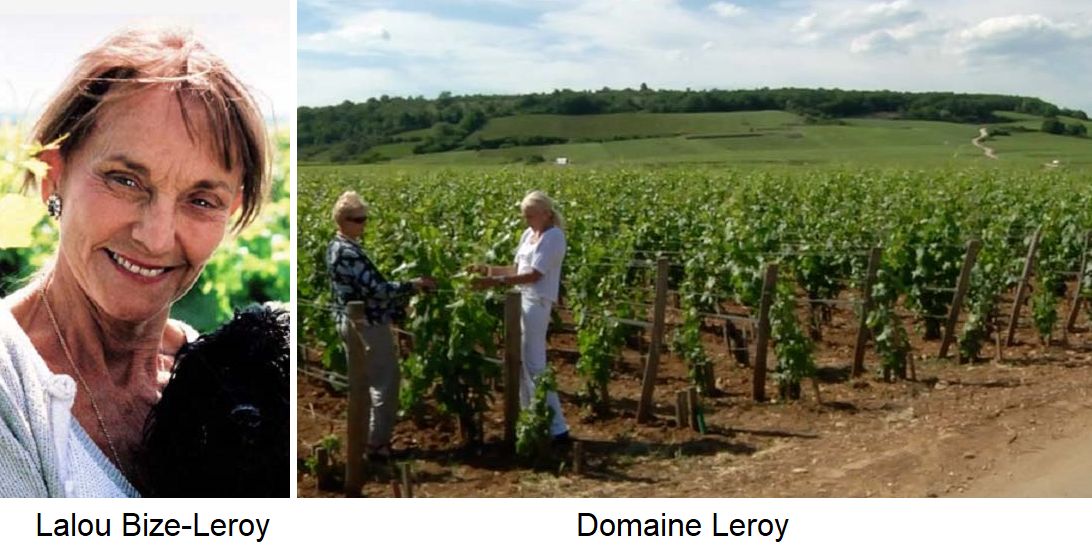The négociant house (trading house) Maison Leroy, with its headquarters in the commune of Meursault in the Côte d'Or area of Burgundy, was founded in 1868 by François Leroy (?-1870) in the commune of Auxey-ut Duresses. He also maintained business relations with the German brandy producer Hugo Asbach (1868-1935). His grandson Henri Leroy (1894-?) expanded the estate to include his own vineyard. In the 1930s, he became a client of the Domaine de la Romanée-Conti and later a friend of the co-owner Edmond Gaudin de Villaine. When the winery ran into financial difficulties in the early 1940s, Henri Leroy bought Jacques Chambon's share in 1942 and became second managing director in 1950. Alongside this, he kept his trading company Leroy S.A., which took over the exclusive distribution of DRC wines. Daughter Lalou Bize-Leroy took over the DCRC management together with Aubert de Villaine (*1939).

In 1988, Lalou bought Charles Noëllat's run-down vineyard and the Domaine Philippe Remy for 65 million francs. To finance this, a third of the shareholding of the trading house Leroy S.A. was sold. The involvement in two wineries was blamed on it as a conflict of interest. This and other long-standing disputes led to a break in the business relationship in 1992. Lalou Bize-Leroy left the DRC and devoted herself to the new Domaine Leroy. The vineyards now cover 22.5 hectares of vines in the famous Burgundian communes of Aloxe-Corton, Chambolle-Musigny, Gevrey-Chambertin, Morey-Saint-Denis, Pommard, Savigny-lès-Beaune, Vosne-Romanée and Vougeot. These are the Grands Crus Chambertin, Clos de la Roche, Corton-Charlemagne (white), Clos de Vougeot, Corton-Renardes, Latricières-Chambertin, Musigny, Richebourg and Romanée-Saint-Vivant, as well as many Premiers Crus.
Since the early 1990s, Madame Bize-Leroy has been an uncompromising advocate of biodynamic viticulture. She was inspired by a visit to the famous winemaker Nicolas Joly at his Château de la Roche-aux-Moines (Loire), who farms uncompromisingly biodynamically. She then converted the farm within a very short time. This means, among other things, the avoidance of chemical fertilisers and pest control as well as the consistent observance of the phases of the moon in all work in the vineyard. Yields are kept extremely low through rigorous pruning, with a maximum of 20 hl/ha. In many plots, the vines are between 50 and 80 years old.
This results in wines of outstanding quality in often very small quantities of only two to three barrels. Most are matured for up to 18 months in 100% new oak barrels, which nevertheless does not lead to an overemphasis of oak spiciness. There is usually no fining or filtration before bottling. Due to the complex vinification process, these wines are among the most expensive in the world. The wines of the Domaine d'Auvenay family estate with vineyards in the Grands Crus Bonnes-Mares, Chevalier-Montrachet and Mazis-Chambertin are vinified extra under this label.
Voices of our members

In the past, you needed a wealth of encyclopaedias and specialist literature to keep up to date in your vinophile professional life. Today, Wine lexicon from wein.plus is one of my best helpers and can rightly be called the "bible of wine knowledge".
Prof. Dr. Walter Kutscher
Lehrgangsleiter Sommelierausbildung WIFI-Wien